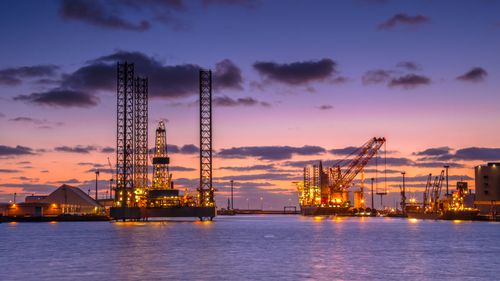SIST EN ISO 13628-11:2008
(Main)Petroleum and natural gas industries - Design and operation of subsea production systems - Part 11: Flexible pipe systems for subsea and marine applications (ISO 13628-11:2007)
Petroleum and natural gas industries - Design and operation of subsea production systems - Part 11: Flexible pipe systems for subsea and marine applications (ISO 13628-11:2007)
ISO 13628-11:2007 provides guidelines for the design, analysis, manufacture, testing, installation and operation of flexible pipes and flexible pipe systems for onshore, subsea and marine applications. ISO 13628-11:2007 supplements ISO 13628-2 and ISO 13628-10, which specify minimum requirements for the design, material selection, manufacture, testing, marking and packaging of unbonded and bonded flexible pipes, respectively.
ISO 13628-11:2007 applies to flexible pipe assemblies, consisting of segments of flexible pipe body with end fittings attached to both ends. Both bonded and unbonded pipe types are covered. In addition, ISO 13628-11:2007 applies to flexible pipe systems, including ancillary components.
The applications covered by ISO 13628-11:2007 are sweet- and sour-service production, including export and injection applications. ISO 13628-11:2007 applies to both static and dynamic flexible pipe systems used as flowlines, risers and jumpers.
ISO 13628-11:2007 does cover, in general terms, the use of flexible pipes for offshore loading systems.
ISO 13628-11:2007 does not cover flexible pipes for use in choke and kill lines or umbilical and control lines.
Erdöl- und Erdgasindustrie - Auslegung und Betrieb von Unterwasser-Produktionssystemen - Teil 11: Flexible Rohrleitungssysteme für Unterwasser- und meerestechnische Anwendung (ISO 13628-11:2007)
Industries du pétrole et du gaz naturel - Conception et exploitation des systèmes de production immergés - Partie 11: Systèmes de canalisations flexibles pour applications sous-marines et en milieu marin (ISO 13628-11:2007)
L'ISO 13628-11:2007 fournit des lignes directrices pour la conception, l'analyse, la fabrication, les essais, la pose et l'exploitation des canalisations flexibles et des systèmes de canalisations flexibles pour les applications terrestres, sous-marines et en milieu marin. L'ISO 13628-11:2007 vient en complément de l'ISO 13628-2 et de l'ISO 13628-10 qui spécifient respectivement les exigences minimales relatives à la conception, au choix des matériaux, à la fabrication, aux essais, au marquage et au conditionnement des canalisations flexibles non collées et composites.
L'ISO 13628-11:2007 s'applique aux ensembles de canalisations flexibles constitués de tronçons de corps de canalisations flexibles munis de pièces d'extrémité fixées aux deux extrémités. Les canalisations composites et les canalisations non collées sont couvertes. En outre, l'ISO 13628-11:2007 s'applique aux systèmes de canalisations flexibles, y compris les composants auxiliaires.
Les applications couvertes par l'ISO 13628-11:2007 sont la production de fluides non corrosifs et corrosifs, y compris les applications d'exportation et d'injection. L'ISO 13628-11:2007 s'applique aux systèmes de canalisations flexibles statiques et dynamiques utilisés comme goulottes, colonnes montantes et tuyaux de raccordement.
L'ISO 13628-11:2007 couvre, en termes généraux, l'utilisation de canalisations flexibles pour les systèmes de chargement en mer.
L'ISO 13628-11:2007 ne couvre pas les canalisations flexibles destinées à être utilisées dans les lignes de duse et dans les conduites d'injection ou dans les ombilicaux et dans les lignes de commande.
Industrija za predelavo nafte in zemeljskega plina - Načrtovanje in delovanje podvodnih proizvodnih sistemov - 11. del: Gibki cevni sistemi za podvodno in pomorsko uporabo (ISO 13628-11:2007)
General Information
Relations
Standards Content (Sample)
2003-01.Slovenski inštitut za standardizacijo. Razmnoževanje celote ali delov tega standarda ni dovoljeno.Erdöl- und Erdgasindustrie - Auslegung und Betrieb von Unterwasser-Produktionssystemen - Teil 11: Flexible Rohrleitungssysteme für Unterwasser- und meerestechnische Anwendung
(ISO 13628-11:2007)Industries du pétrole et du gaz naturel - Conception et exploitation des systèmes de production immergés - Partie 11: Systèmes de canalisations flexibles pour applications sous-marines et en milieu marin (ISO 13628-11:2007)Petroleum and natural gas industries - Design and operation of subsea production systems - Part 11: Flexible pipe systems for subsea and marine applications (ISO 13628-11:2007)75.180.10Oprema za raziskovanje in odkopavanjeExploratory and extraction equipmentICS:Ta slovenski standard je istoveten z:EN ISO 13628-11:2008SIST EN ISO 13628-11:2008en01-september-2008SIST EN ISO 13628-11:2008SLOVENSKI
STANDARD
EUROPEAN STANDARDNORME EUROPÉENNEEUROPÄISCHE NORMEN ISO 13628-11June 2008ICS 75.180.10 English VersionPetroleum and natural gas industries - Design and operation ofsubsea production systems - Part 11: Flexible pipe systems forsubsea and marine applications (ISO 13628-11:2007)Industries du pétrole et du gaz naturel - Conception etexploitation des systèmes de production immergés - Partie11: Systèmes de canalisations flexibles pour applicationssous-marines et en milieu marin (ISO 13628-11:2007)Erdöl- und Erdgasindustrie - Auslegung und Betrieb vonUnterwasser-Produktionssystemen - Teil 11: FlexibleRohrleitungssysteme für Unterwasser- undmeerestechnische Anwendung
(ISO 13628-11:2007)This European Standard was approved by CEN on 16 May 2008.CEN members are bound to comply with the CEN/CENELEC Internal Regulations which stipulate the conditions for giving this EuropeanStandard the status of a national standard without any alteration. Up-to-date lists and bibliographical references concerning such nationalstandards may be obtained on application to the CEN Management Centre or to any CEN member.This European Standard exists in three official versions (English, French, German). A version in any other language made by translationunder the responsibility of a CEN member into its own language and notified to the CEN Management Centre has the same status as theofficial versions.CEN members are the national standards bodies of Austria, Belgium, Bulgaria, Cyprus, Czech Republic, Denmark, Estonia, Finland,France, Germany, Greece, Hungary, Iceland, Ireland, Italy, Latvia, Lithuania, Luxembourg, Malta, Netherlands, Norway, Poland, Portugal,Romania, Slovakia, Slovenia, Spain, Sweden, Switzerland and United Kingdom.EUROPEAN COMMITTEE FOR STANDARDIZATIONCOMITÉ EUROPÉEN DE NORMALISATIONEUROPÄISCHES KOMITEE FÜR NORMUNGManagement Centre: rue de Stassart, 36
B-1050 Brussels© 2008 CENAll rights of exploitation in any form and by any means reservedworldwide for CEN national Members.Ref. No. EN ISO 13628-11:2008: E
Reference numberISO 13628-11:2007(E)© ISO 2007
INTERNATIONAL STANDARD ISO13628-11First edition2007-09-15Petroleum and natural gas industries — Design and operation of subsea production systems — Part 11: Flexible pipe systems for subsea and marine applications Industries du pétrole et du gaz naturel —Conception et exploitation des systèmes de production immergés — Partie 11: Systèmes de canalisations flexibles pour applications sous-marines et en milieu marin
ISO 13628-11:2007(E) PDF disclaimer This PDF file may contain embedded typefaces. In accordance with Adobe's licensing policy, this file may be printed or viewed but shall not be edited unless the typefaces which are embedded are licensed to and installed on the computer performing the editing. In downloading this file, parties accept therein the responsibility of not infringing Adobe's licensing policy. The ISO Central Secretariat accepts no liability in this area. Adobe is a trademark of Adobe Systems Incorporated. Details of the software products used to create this PDF file can be found in the General Info relative to the file; the PDF-creation parameters were optimized for printing. Every care has been taken to ensure that the file is suitable for use by ISO member bodies. In the unlikely event that a problem relating to it is found, please inform the Central Secretariat at the address given below.
©
ISO 2007 All rights reserved. Unless otherwise specified, no part of this publication may be reproduced or utilized in any form or by any means, electronic or mechanical, including photocopying and microfilm, without permission in writing from either ISO at the address below or ISO's member body in the country of the requester. ISO copyright office Case postale 56 • CH-1211 Geneva 20 Tel.
+ 41 22 749 01 11 Fax
+ 41 22 749 09 47 E-mail
copyright@iso.org Web
www.iso.org Published in Switzerland
ii © ISO 2007 – All rights reserved
ISO 13628-11:2007(E) © ISO 2007 – All rights reserved iiiContents Page Foreword.v Introduction.vi 1 Scope.1 2 Normative references.1 3 Terms, abbreviated terms, definitions and symbols.2 3.1 Terms and definitions.2 3.2 Symbols and abbreviated terms.4 4 System, pipe, and component description.6 4.1 Introduction.6 4.2 Flexible pipe systems.8 4.3 Flexible pipe description.15 4.4 Ancillary components.24 5 Pipe design considerations.35 5.1 General.35 5.2 Design overview.35 5.3 Failure modes.40 5.4 Design criteria.43 5.5 Load cases.50 6 Materials.55 6.1 Scope.55 6.2 Materials — Unbonded pipe.55 6.3 Materials — Bonded pipe.60 6.4 Alternative materials.64 6.5 Polymer/elastomer test procedures.66 6.6 Metallic-material test requirements.69 7 System design considerations.72 7.1 General.72 7.2 General system requirements.72 7.3 Flowline design requirements.75 7.4 Riser design requirements.79 7.5 Ancillary components.82 7.6 System interfaces.86 8 Analysis considerations.87 8.1 Introduction.87 8.2 Analysis techniques.87 8.3 Loads.96 8.4 Global-response evaluation.99 9 Prototype testing.103 9.1 General.103 9.2 Design programmes.104 9.3 Classification of prototype tests.104 9.4 Test requirements.105 9.5 Test protocol.109 9.6 Procedures — Standard prototype tests.111 9.7 Procedures — Special prototype tests.116 10 Manufacturing.130 10.1 General.130
ISO 13628-11:2007(E) iv © ISO 2007 – All rights reserved 10.2 Manufacturing — Unbonded pipe.130 10.3 Manufacturing — Bonded pipe.135 10.4 Marking.137 10.5 Storage.140 11 Handling, transportation, and installation.141 11.1 General.141 11.2 Handling.141 11.3 Transportation.143 1
...











Questions, Comments and Discussion
Ask us and Technical Secretary will try to provide an answer. You can facilitate discussion about the standard in here.